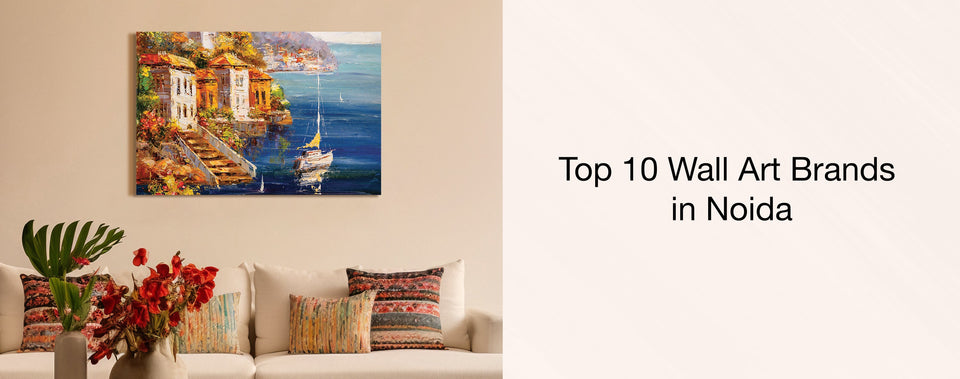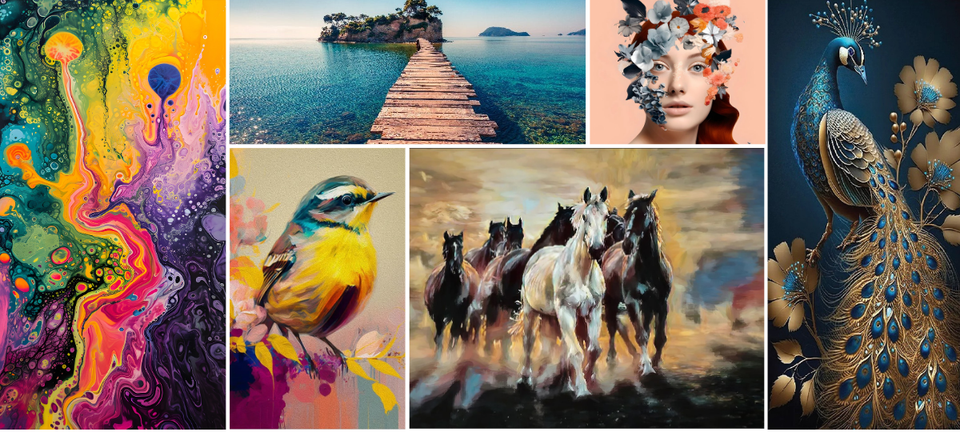Easy Ideas for Abstract Art: Experimenting with Colors and Shapes on Canvas
by Anciq Anciq on Sep 07, 2024
Creating abstract art can indeed be a thrilling approach towards expressing one’s creativity. People who practice this form of artistic expression employ colors, shapes, and forms in their pieces thereby making abstract art more so about emotional communication than anything else. This technique is quite simple and can help anyone create an easy abstract painting intended for adding character and personal expression.
While both a professional artist and a novice one, continuum explores abstract art, this topic is full of experimentation. This blog will show you possible choices for diving into abstract art and what simple techniques can be used to make impressive canvas paintings.
Why Abstract Art?

Abstract art sometimes has a reputation for being chaotic or random, but it goes beyond that point. An artist can concentrate on emotional and aesthetic aspects of a piece of art using this type of painting, leaving a lot to interpretation. In the first half of the 20th century, abstract art gained momentum with people like Wassily Kandinsky, Piet Mondrian, and others at the forefront. Kandinsky thought colors or shapes could represent soil forms and spiritual experiences, while Mondrian focused on harmony and balance in geometric figures.
The abstract visual expression keeps changing in the present day, where modern abstract paintings apply different techniques, materials and even digital mediums to convey the same eternal feelings. Thus, those who want to know about this art can commence with straightforward concepts such as shapes and colors.
Getting Started: Basic Tools for Abstract Art

The right tools are important before you start your journey for creating an abstract artwork. Thankfully, abstract art doesn’t require any expensive materials or specialized tools. So, here’s a list of some basic supplies that you will need to begin:
- Canvas: As there are a variety of sizes, to begin with, a small canvas is less intimidating for beginners..
- Acrylic Paints: Given that paint coatings are often thick, they are made from resins that evaporate quickly during the drying process. Thus, any beginner can easily use them to learn how to paint as they will dry faster compared to oils or any other type of coating.
- Brushes: A variety of brushes in different sizes and shapes will help you achieve various textures and strokes.
-
Palette Knife or Sponge: These tools are awesome for incorporating texture and blending colors in fresh, innovative ways.
Easy Ideas and Techniques for Abstract Art

1. Color Blocking
A very simple way of starting up with this concept is through experimenting with color blocking. The method entails dividing the canvas into distinct portions and filling each portion using solid color only. This technique enables one to pay attention solely to the interplay of colors rather than anything else.
For instance, you have the option of dividing your canvas into geometric figures such as square shapes, rectangular forms or even jagged polygonal structures; then you are to fill each figure with a color that stands out against the others. This method is best suited for novices since it does not involve intricate processes yet produces a visually captivating artistic creation.
2. Drip Painting
Drip painting, as inspired by Jackson Pollock, can be considered a fun and spontaneous technique of dripping or splattering paint all over the canvas. It is possible to use anything from a brush to a stick or even just bare fingers in order to flick some paint onto the piece of canvas. What comes out is a lively and active arrangement showing motion as well as
Drip painting is all about how it allows us to relinquish control and permit paint to flow freely. This technique is particularly popular among people who want to play around with bright colors and different textures without being tied down too much by structure.
3.Geometric Shapes and Patterns
In modern abstract art, geometric patterns come out akimbo. Commence each work of art by adding simple shapes such as circles, squares or triangles and getting them filled up with different colors or textures. If you want it to be more intricate you may choose to overlap the designs so as to add the layering aspect.
You get to play around with symmetry, balance, and contrast which are the three main principles of producing beautiful abstract art when using this technique. Also, this approach helps create orderly and organized abstract canvas paintings suited to those artists who are obsessed with structure.
4. Layering Colors
In abstract art, layering is a technique that allows for the addition of colors one by one so as to let them dry before applying another layer. With the use of a palette knife, sponge, or even your fingers, thin coats of paint can be put on top of each other to create depth and texture.
Novices may experiment with using different light and dark shades of the same color, which can result in astonishing outcomes. The various layers will make it appear as if your canvas painting has movement and is flowing, thus giving a unique three-dimensional effect.
5. Mixing Media
Dare to go past just adding colors to a canvas; include other materials in your paintings. For instance, you may use sands, textiles, or even remnants of paper so as to give some texture. The combination with paint opens doors for numerous possibilities in terms of textural and depth effects in artistic creations.
Abstract art created by using different media offers a platform for unlimited experimentation because it allows one to use a variety of textures, colors, and techniques in order to create something that is really one of a kind.
Final Tips for Success.

- Experiment with Color Palettes: The understanding of color theory will lift your abstract work to a higher level. For contrast, try complementary colors (on the color wheel they are opposite), or for harmony, try analogous colors (next to one another).
- Don’t Overthink It: Chaos is the main aspect of abstract art. More often than not, it is the chaos that brings out the best in some artworks since they arise accidentally.
-
Practice, Practice, Practice: The more you experiment, the more confident you’ll become. New techniques should be tried out, elements played with in combinations, and most importantly, have fun doing so.
Conclusion
The initial step towards creating a simple and easy abstract painting is to explore your emotions and express them without any limitation. You may apply any type of drip, color blocking, or geometric pattern; it does not matter what technique you adopt, but your own imagination should determine how the artwork turns out. By employing suitable materials and being ready for trials, you can make beautiful easy canvas paintings that resemble your individuality as an artist.
Abstract art has no limits; geometrical simplicity, deep layered colors—it can have various forms. By introducing modern components and using other media, you can paint your personal and inimitable modern abstraction. So, start with little modifications in colors or shapes and find yourself producing abstract artworks that are so much like you!






